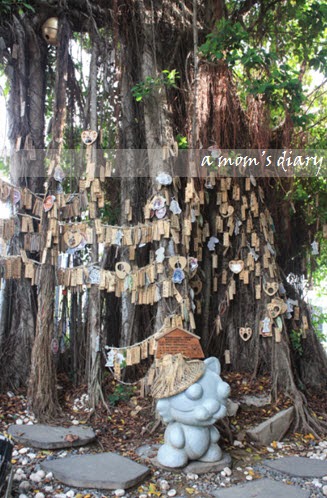An interesting trivia: the original statues in the foreground has the Dutch general (with back facing us)kneeling in surrender, but two years after it was commissioned, it was changed to a standing posture at the request of the Dutch when Taiwan wanted to purchase submarines from them J
Row of nine turtle statues bearing giant tablets from the Qing imperial court
Windows at Chihkan Tower. Bill Gate may have to pay royalty to Taiwan J
One of the temple within is a popular place for Taiwanese to pray for good exam results. Photo above are all wishes hung on the board at the back of the temple.
The original Fort Provintia was completely destroyed during the Qing Dynasty. What remains of the original Dutch building is this brick wall.
Main entrance to the Confucius Temple. The granite stele is the “dismount monument” (下马碑), indicating that visitors must dismount from their horses and proceed from this point on foot, to show their respect for Confucius.
The Edification Hall (明倫堂) - this was used for the study of Confucius classics and open only to those scholars who passed the Imperial examinations
Chongsheng (崇聖) Hall – since 1723, the first five generations of Confucius’ ancestors have been worshipped in this temple. Aside from honoring the birth of a great thinker, it is also to encourage scholars to worship their ancestors, as filial piety is one of the key teachings of Confucius.
There are many statues like this around the Chongsheng Hall but this little fella stood out as the only one with a playful feature
We headed for lunch after that at a hot pot restaurant frequented by locals, San Ta Beef Hot Pot (三大牛肉火鍋). What’s unique about this restaurant is that they serve fresh, instead of frozen beef, for their hot pot.
After lunch, we went to the Ten Drums Culture Village (十鼓文化村), converted from an old sugar refinery. This is home to the Ten Drum Art Percussion Group, which I learnt scored a Grammy nomination in the Best Traditional World Music Album category in 2009. The group has also performed at the Summer Olympics in Sydney in 2000 and the 2002 World Cup in South Korea.
We had a guide who took us on a tour around the village. We started at the East Asian drum museum with displays of traditional drums from Taiwan, China, South Korea and Japan.
We were then ushered to theatre for the highlight of the tour, the 30-min Ten Drum show. Since we weren’t allowed to take pics, I borrowed this photo from here.
We were then taken to the drumming experience room to learn some drumming skills. We then killed some time walking around the remnants of the sugar refinery.
Remnants from the sugar refinery
We
took the high speed train back to Taipei after the visit to the Ten Drums
Culture Village. I’m glad we had the two
days break in Tainan before the gruelling 5-day meeting in Taipei. Mum, on the other hand, went on to visit
Taroko Gorge, Sun Moon Lake, Puli, Lukang, Alishan, Shifen and Pingxi with the
other mums. Wished I was in her
shoes J





























































